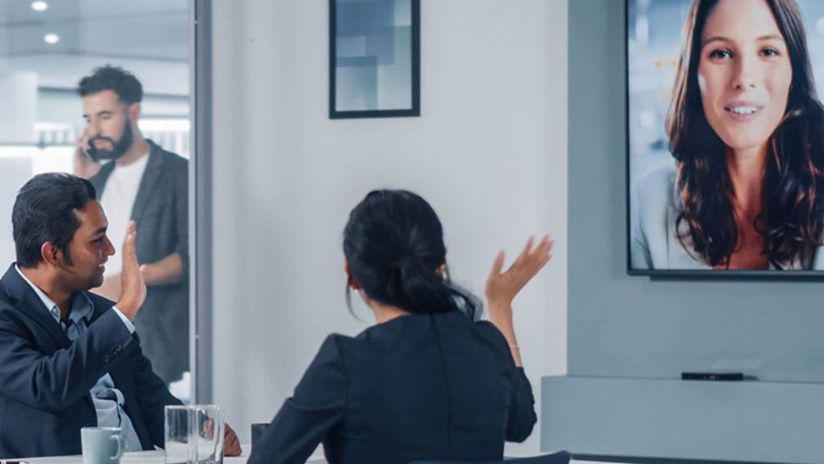Catering for hybrid meetings as part of your digital transformation

“Digital transformation” – a term currently being thrown around in workplaces around the world. Maybe your technology partner has used it, perhaps you’ve googled it, or it was the topic of a recent webinar or roundtable you attended. There’s no question it’s one of today’s buzzwords and for good reason.
We’ve been digitally transforming the way we work for decades. We call clients and colleagues on their mobiles, drop appointments into an online calendar, email documents to stakeholders and e-sign contracts. The move to virtual meetings, and joining a predominantly in-person meeting, remotely, are just another natural transformation.
The way businesses approach hot-desking and remote working provides more flexibility to team members. We’ve acknowledged that employees no longer need to be in the office to carry out their work, share files or manage projects – cloud working and video calling assist in making hybrid working a success.
Some individuals prefer working from home, some like to come into an office, and some enjoy a mix of both. As an organisation, it’s imperative that the setup of the office and the technology staff have access to both in the office and at home, allow them to work and collaborate effectively in all scenarios.
Virtual meetings
When it comes to virtual meetings it’s important to have a strong internet connection, good quality audio and visual equipment, and a platform that’s easy to use with the functionality your team needs. This could include large capacity meetings, recording, chat and file sharing, collaboration tools, breakout groups, virtual backgrounds, screen sharing, the ability to mute participants and see when you’re on mute, and integration with your calendar/email.
When many organisations made the shift to virtual meetings, they did so very quickly and deployed a solution that fit the purpose at the time. Now that virtual and hybrid meetings are here to stay, organisations are reconciling their platforms and applications – opting for a solution that’s more robust and can even integrate with their telephony solution.
With people gradually spending more days in the office, it’s become increasingly important that the virtual meeting platform your organisation uses, is quick and easy to join from your office meeting rooms as well.
Hybrid meetings
When we all sit around the table in a physical meeting room, the requirements are more basic – comfortable chairs, note taking tools, a screen for a presentation, perhaps a white board for collaborating. However, when some of the team are in the meeting room and others are dialling in for the meeting, there’s more to factor in if you want to help ensure a productive meeting.
The Top 5 elements for a meeting room are:
- Consistent, easy to use user experience
- Audio quality
- Appropriately sized display
- Appropriate camera technology
- The ability to share content
Consistent, easy to use user experience
No one wants to spend the first 10 minutes of every meeting remembering/navigating how to set up the conference call, how to share content to the screen or how to change the camera setting so it follows the speaker. You want the user experience to be consistent and as simple as possible so the meeting time can be spent in the meeting itself, rather than troubleshooting, and staff aren’t dissuaded from using your meeting rooms.
Audio quality
Yes, it’s important to see what’s going in a meeting - seeing who is speaking helps with understanding context and following up. It also helps prevent others from interrupting and attendees talking over each other; plus, there’s the added benefits of body language and facial expressions. However, if you had the best cameras on the market and first-class visibility but all participants were inaudible, the meeting will fail. Whilst not ideal, if you lost camera functionality but the audio was crystal clear, you could still hold the meeting.
There is a difference between just having a microphone in the room and having reliably high-quality audio. When a meeting participant sounds ‘underwater’, crackly or like the microphone is too far away – it not only delays the meeting progress if you have to ask them to repeat themselves, or adjust the mic, but it disrupts the flow of the conversation as well and can compromise or diminish the output of the meeting. In a larger meeting room with many speakers the A/V technology you install can make a substantial difference for attendees dialling in remotely.
Appropriately sized display
Though not an issue for those joining remotely, for anyone in the meeting room the size of the screen is important. When the screen is too big those nearest to it may not be able to see the whole screen or might have to crane their necks to take it in. If the screen’s too small, it means those in the front are squinting to make out the content and anyone further away probably won’t be able to see it at all. In both cases meeting productivity suffers because participants can’t focus on, or can’t see, the content being presented.
Viewing distance, viewing angles, aspect ratios and most common content types all come into play when choosing the best sized display for your meeting room.
Appropriate camera technology
For virtual meetings, many people still opt to use the inbuilt camera in their monitor or laptop. However, an external camera can really improve sharpness, low light performance, colour and more.
When it comes to using cameras in your physical meeting rooms, the size of your meeting room can play a factor in choosing the right camera. Meeting room cameras enable dial-in participants to see everyone in the room all at once and can home in on different people, so remote workers can see who is speaking, and more easily follow the meeting. Some cameras will move to follow the presenter. Cameras with AI-powered zooming and panning automatically include everyone on the call, without the physical camera needing to move and distract you. Other cameras automatically frame every participant, which some find preferable to rapidly moving from one speaking participant to the next. Some cameras also use AI to adjust the lighting in dim and darker rooms.
The ability to share content
Sharing content needs to be a quick and easy process for the presenter. This saves time practising before the meeting or fumbling around during the meeting, which wastes time and breaks the flow. It should also be simple and quick to change the content being shared when the next presenter needs to share their screen.
The content should be visible and large enough on the meeting room screen, and also clearly visible for those joining remotely.
Seamless hybrid meetings
In mid-2020, virtual meetings could sometimes feel a little clunky as we adjusted to using a different application interface and feature set depending on whether the meeting host was using Teams, Webex, Zoom or something else entirely. We weren’t sure if we were on mute or not and had to repeatedly ask others to mute themselves. With the sheer volume of remote meetings we’ve hosted and joined in the last two years, this is no longer too problematic.
Today, hybrid meetings can be a bit of a challenge. Optimising your workspaces to enable productive hybrid meetings and new post pandemic ways of working will form part of your digital transformation. If you’d like help understanding your options to decide which solutions will best suit your space and objectives, or are ready to upgrade your meeting rooms, our workplace team and AV/VC specialists are here to help.
Let’s talk about meeting rooms: Let’s talk about meeting rooms


